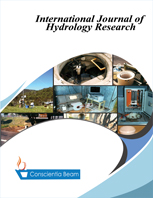Runoff Response to Climate Variability: An Analysis of Thika River Basin in Kenya Using Hydrological Simulation Model (Hysim)
DOI:
https://doi.org/10.18488/journal.108.2017.21.1.12Abstract
Changes in climatic conditions have greatly affected surface runoff and stream flows both at local and global scale. This has led to adverse effects on surface run off and climatic system as a whole. Research on these hydrological changes at basin scale is of great importance to the water managers for the future planning and management of water resources. In this study, a Hydrological simulation model (HYSIM) was used to simulate runoff and quantify the effects of climate variability on runoff within the area of study. The model was calibrated and validated giving a coefficient of determination (R2) of 0.923, an RMSE of 0.56 and a BIAS of 1.697 respectively. The future climate of the catchment is projected to be warmer and, with less confidence, wetter as simulated using the IPCC scenarios. However, stream flow could increase by between 1.2% on the lower case to 4.5% on the higher case under these projections. There is therefore need to prepare for the increased runoff as it would affect the agricultural sector, industry, urban communities, as well as the environment.

